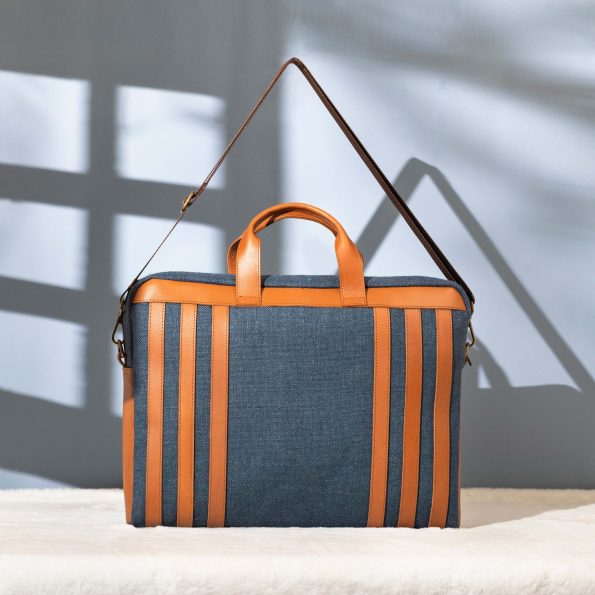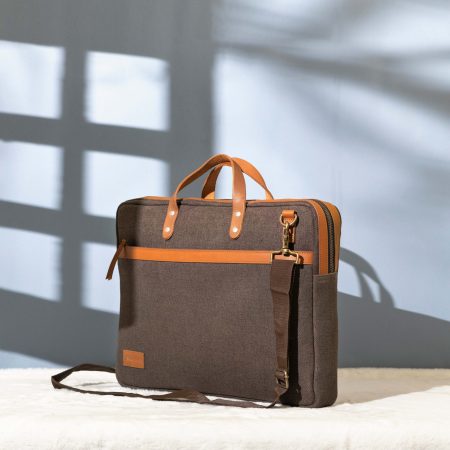Karnaphuli
৳ 1,200.00
This vintage design laptop bag is called “Karnaphuli”.
Office, campus, or business trip to keep your favorite laptop safe Kalindi designed this laptop bag. Made out of premium quality jute fabric, this laptop bag can be an essential companion to your favorite laptop.
– Measurements: 12″ × 16″ × 3″
– Available in two different colors.
– Material: High-quality jute fabric and vegetable tanned leather.
ভিন্টেজ ডিজাইনের এই ল্যাপটপ ব্যাগটির নাম “কর্ণফুলী”।
অফিস, ক্যাম্পাস, অথবা ব্যবসায়িক ভ্রমণে আপনার প্রিয় ল্যাপটপটিকে সুরক্ষিত রাখতে এবং সহজে বহন উপযোগী করে তুলতে কালিন্দী তৈরি করেছে বেস্ট কোয়ালিটির ল্যাপটপ ব্যাগ। পাটের তৈরি এই ল্যাপটপ ব্যাগটি হতে পারে আপনার প্রিয় ল্যাপটপের প্রয়োজনীয় সঙ্গী।
– সাইজঃ ১২” × ১৬” × ৩”।
– মেটেরিয়ালঃ পাটের ফেব্রিক এবং ভেজিটেবল ট্যানড লেদার।
- Delivery & Return
Delivery
আমরা পুরো বাংলাদেশে হোম ডেলিভারি দিয়ে থাকি। ডেলিভারির সময় ২-৫ দিন। পণ্যের আকার, ওজন এবং আপনার লোকেশনের উপর নির্ভর করে ৮০-১৫০ টাকা ডেলিভারি চার্জ প্রযোজ্য।Return
আমরা প্রতিটি পণ্য খুবই যত্নের সাথে কোয়ালিটি কন্ট্রোল করি। পণ্যটি নেওয়ার সময় অবশ্যই ভালোভাবে চেক করে নেওয়ার অনুরোধ রইল। এর পরও যদি কোন সমস্যা হয় তাহলে ডেলিভারির ৭ দিনের মধ্যে রিফান্ডের (শর্ত সাপেক্ষে) ব্যবস্থা আছে।Help
যেকোন প্রয়োজনে আমাদের সাথে যোগাযোগ করুন। Facebook: https://www.facebook.com/kalindi.com.bd Phone: +880 1810151890 Email: [email protected]
কর্ণফুলী
আসামের লুসাই পাহাড়ের লুগলেহ অঞ্চল থেকে এসেছে তুই চাং এবং বাংলাদেশ-মিয়ানমার সীমান্ত থেকে এসেছে তুইলিয়াং পুই স্রোতধারা। এই দুই স্রোতধারা মিশেছে পার্বত্য রাঙ্গামাটি জেলার কাছে মিজোরাম সীমান্তের দেমাগিরিতে। এই দুই স্রোতধারার সম্মিলন থেকে কর্ণফুলী নদীর উৎপত্তি। লুসাই পাহাড় থেকে আসা তুই চাং-ই কর্ণফুলীর মূল স্রোতধারা। পার্বত্য চট্টগ্রামের বিশাল এলাকা জুড়ে এই নদীর বিস্তার। দৈর্ঘ্যে এ নদী প্রায় ৩২০ কিমি। রাঙ্গামাটি জেলার বরকল, কাপ্তাই, রাঙ্গামাটি, বড়ইছড়ি, চন্দ্রঘোনা, রাঙ্গুনিয়া, কালুরঘাট ও চট্টগ্রাম শহরের পাশ দিয়ে পতেঙ্গার কাছে এই নদী বঙ্গোপসাগরে পড়েছে। কর্ণফুলীর ওপরের দিকের স্রোতে জলপ্রপাত আছে। তার মধ্যে মিজোরামের দেমাগিরি এবং পার্বত্য রাঙ্গামাটি জেলার বরকল জলপ্রপাত বিখ্যাত।
কর্ণফুলীর নামকরণ নিয়ে সবচেয়ে প্রচলিত কিংবদন্তি হলো, এই অঞ্চলে এক মগ রাজা ছিলেন। তাঁর সুন্দরী কন্যা এক যুব সওদাগরের প্রেমে পড়ে। বাণিজ্যের জন্য অন্য বন্দরে যাওয়ার সময় হলে বিয়ের প্রতিশ্রুতি দিয়ে সওদাগর চলে যায়। স্মৃতি হিসেবে রাজকন্যাকে দিয়ে যায় এক জোড়া কানের দুল। সময় যেতে থাকে, রাজকন্যার বিয়ে ঠিক করে রাজা কিন্তু সওদাগর আর ফেরে না। বিরহব্যথায় কাতর রাজকন্যা নদীর বুকে আত্মাহুতি দেয়। সেই ঘটনার স্মরণে নদীটির নামকরণ হয়েছে কর্ণফুলী। ‘কর্ণফুলী’র অর্থ কানের দুল বা কানের ফুল। কর্ণফুলী পার্বত্য চট্টগ্রামের মানুষের জীবনের সঙ্গে গভীরভাবে সম্পৃক্ত। কর্ণফুলী এ অঞ্চলের সংস্কৃতিকেও সমৃদ্ধ করেছে। কর্ণফুলী নিয়ে মলয় ঘোষ দস্তিদারের লেখা ‘চোড চোড ঢেউ তুলি’ গানটি সম্ভবত সবচেয়ে বিখ্যাত। কর্ণফুলীকে ঘিরে এমন অসংখ্য সুখ-দুঃখ, হাসিকান্না, বিরহ-মিলনের গান চট্টগ্রামে প্রচলিত রয়েছে। কর্ণফুলীর হাজার বছরের ঐতিহ্য সাম্পানের মাঝিকে নিয়ে সবচেয়ে বেশি গান রচিত হয়েছে। সংগীতজ্ঞ মোহনলাল দাশ কর্ণফুলীর মাঝিকে নিয়ে বেঁধেছেন, ‘ওরে সাম্পানওয়ালা/ তুই আমারে করলি দিওয়ানা’ গানটি। ‘সাম্পানওয়ালা’ নামে চট্টগ্রামের আঞ্চলিক ভাষায় একটি ছায়াছবি নির্মিত হয়েছে। কাজী নজরুল ইসলাম তাঁর কবিতায় কর্ণফুলীর প্রাণবন্ত বর্ণনা দিয়েছেন।
কর্ণফুলী তীরে চন্দ্রঘোনায় এশিয়ার বৃহত্তম কাগজের কল আছে। এ নদীর মোহনায় বাংলাদেশের বৃহত্তম সমুদ্রবন্দর (চট্টগ্রাম) অবস্থিত। বৃটিশ শাসনামলে ১৯০৬ থেকে ১৯৪৬ সাল পর্যন্ত ‘কর্ণফুলী নদী থেকে বিদ্যুৎ উৎপাদনের জরিপ ও চেষ্টা শুরু হয়। পরে ১৯৫১ সালে আমেরিকার সহযোগিতায় এই নদীতে ‘কর্ণফুলী বহুমুখী পরিকল্পনা’ গ্রহণ করা হয় এবং ১৯৬২ সালের মার্চে দাতা সংস্থা ইউসএইড (USAID)-এর সহায়তায় কাপ্তাই বাঁধ নির্মাণ শেষ হয়। এই পরিকল্পনায় বিদ্যুৎ উৎপাদন, বন্যা নিয়ন্ত্রণ, সেচ, নৌ-চলাচল, মৎস্য চাষ অন্তর্ভুক্ত হয়। কাপ্তাই বাঁধের উচ্চতা ১৫৩ ফুট, দৈর্ঘ্য ২ হাজার ২০০ ফুট। বাঁধের ফলে ২৫৬ বর্গমাইল আয়তনের হ্রদ বা জলাধার সৃষ্টি হয়েছে। এর ফলে ৬৫৫ বর্গ কিলোমিটার এলাকা প্লাবিত হয়, যার মধ্যে পার্বত্য চট্টগ্রামের মোট কৃষি জমির প্রায় ৪০% (২২,০০০ একর) পানিতে তলিয়ে যায়। কাপ্তাই লেক নির্মাণে প্রায় ১৮,০০০ মানুষের ঘরবাড়ি বিলুপ্ত হয়েছে, প্রায় ১০০,০০০ মানুষকে তাদের আবাসভূমি থেকে সরে যেতে হয়েছে, যার মধ্যে ৭০% চাকমা জনপদের মানুষজন। আবাসভূমি থেকে বিতাড়িত হয়ে প্রায় ৪০,০০০ চাকমা ভারতের ত্রিপুরা, মিজোরাম ও অরুণাচল প্রদেশে শরণার্থী হিসেবে আশ্রয় নেয়, তাদেরকে ‘পরিবেশগত কারণে সৃষ্ট শরণার্থী’ হিসেবে চিহ্নিত করা হয়। ভারত থেকে এই শরণার্থীদের দেশে ফিরিয়ে এনে সুষ্ঠুভাবে পুনর্বাসনের জন্য এবং দেশের ভিতরে উদ্বাস্তুদের চিহ্নিত করে তাদের পুনর্বাসনের লক্ষ্যে বাংলাদেশ সরকার ১৯৯৭ সালে ‘ভারত প্রত্যাগত উপজাতীয় শরণার্থী প্রত্যাবাসন ও পুনর্বাসন এবং অভ্যন্তরীণ উদ্বাস্তু নির্দিষ্টকরণ ও পুনর্বাসন সম্পর্কিত টাস্কফোর্স’ গঠন করে। শরণার্থীদের জন্য সরকার ঘোষিত ২০ দফা প্যাকেজ সুযোগ সুবিধা দ্রুত বাস্তবায়নে দিকনির্দেশনা দেয়া ও সহায়তা করা, সরেজমিনে পুনর্বাসিত শরণার্থীদের বাড়িঘর পরিদর্শন ও স্থানীয়ভাবে কোনও সমস্যা দেখা দিলে তার সমাধানের জন্য সংশ্লিষ্ট কর্তৃপক্ষের কাছে প্রস্তাবনা উপস্থাপন, প্রত্যাবর্তন ও পুনর্বাসন কার্যক্রম পর্যবেক্ষণ করা ও প্রয়োজনে সরকারকে পরামর্শ দেয়া সহ আরও বেশ কিছু সুনির্দিষ্ট কাজ করে থাকে এই টাস্কফোর্স।
বিদ্যুৎ উৎপাদন ছাড়াও অর্থনীতিতে কর্ণফুলী নদী নানামুখী অবদান রাখছে। অতীতে এই নদীতে প্রচুর পরিমাণে মাছ পাওয়া যেত। কর্ণফুলী নদী ঘিরে যুগ যুগ ধরে জীবিকা চালিয়ে আসছেন স্থানীয় জেলেরা। নদীতে আর আগের মতো মাছের প্রাচুর্য্য নেই। দূষণসহ নানা কারণে ইতিমধ্যে বিলুপ্তির পথে এ নদীর প্রায় ৩০ প্রজাতির মাছ। একসময় কর্ণফুলীতে মিঠা, মিশ্র (মিঠা ও লবণাক্ত) ও সামুদ্রিক (লবণাক্ত) মাছের বিচরণক্ষেত্র ছিল। এই নদীতে প্রায় ১৪০ প্রজাতির মাছ পাওয়া যেত, এর মধ্যে মিঠাপানির মাছ ৬৬ প্রজাতির, মোহনায় লবণাক্ত পানির মাছ ৫৯ প্রজাতির এবং সামুদ্রিক নোনা পানির মাছ ছিল ১৫ প্রজাতির। বনজ সম্পদ, যেমন বাঁশ, বেত, কাঠ এসব পরিবহনেও এ নদীর ব্যাপক অবদান রয়েছে। এ অঞ্চলের পার্বত্য শ্রেণিকে আর্দ্র রাখতে যথেষ্ট ভূমিকা রাখছে কর্ণফুলী। যার ফলে এ পাহাড়শ্রেণি তুলনামূলকভাবে কম রুক্ষ ও শুষ্ক। এখানকার প্রাণিবৈচিত্র্য দীর্ঘজীবী হওয়ার প্রধান কারণ হচ্ছে পাহাড়িয়া এই নদী। পানি সহজলভ্য হওয়ায় নানান প্রজাতির প্রাণীর ব্যাপক সমাবেশ ঘটেছে এখানে।
Karnaphuli
The Karnaphuli River, a vital waterway in Bangladesh, originates from the Lushai Hills of Assam, where two streams, Tuichang from the Luglei region and Tuichangpui from the Bangladesh-Myanmar border, merge near Demagiri on the Mizoram border, close to the Rangamati district in the Chittagong Hill Tracts. The primary stream of the Karnaphuli comes from the Tuichang of the Lushai Hills. The river spans approximately 320 kilometers, flowing through the Chittagong Hill Tracts, passing through Borokhola, Kaptai, Rangamati, Boroichhari, Chandraghona, Rangunia, Kaluirghat, and Chittagong city, before emptying into the Bay of Bengal near Patenga. The upper reaches of the Karnaphuli feature notable waterfalls, including the famous Demagiri in Mizoram and Borokhola waterfall in the Chittagong Hill Tracts.
The most popular legend about the naming of the Karnaphuli involves a Mughal king in the region. His beautiful daughter fell in love with a young merchant who, while departing for another port for trade, promised to marry her and left a pair of earrings as a memento. Time passed, and the king arranged his daughter’s marriage, but the merchant never returned. Heartbroken, the princess drowned herself in the river. In her memory, the river was named Karnaphuli, which means “earring” in Bengali. The Karnaphuli is deeply intertwined with the lives of the people in the Chittagong Hill Tracts and has enriched the region’s culture. One of the most famous songs about the Karnaphuli is “Chhod Chhod Dheu Tuli ” by Moloy Ghosh Dastidar. Numerous songs reflecting joy, sorrow, separation, and reunion have been composed around the Karnaphuli. Many of these songs, especially those about the boatmen of the Karnaphuli, are popular. Renowned musician Mohanlal Das composed the song “Ore Sampanwala/Tui Amare Korli Diwana ” about the boatmen of the Karnaphuli. A regional film titled “Sampanwala” was made in the Chittagong dialect. Kazi Nazrul Islam vividly described Karnaphuli in his poetry.
Chandraghona, located on the banks of the Karnaphuli, houses Asia’s largest paper mill. At the river’s mouth, Bangladesh’s largest seaport, Chittagong, is situated. During British rule, from 1906 to 1946, surveys and attempts were made to generate electricity from the Karnaphuli. Later, in 1951, with American cooperation, the “Karnaphuli Multipurpose Project” was initiated, and in March 1962, with the assistance of USAID, the Kaptai Dam was completed. This project included electricity generation, flood control, irrigation, navigation, and fish farming. The Kaptai Dam is 153 feet high and 2,200 feet long, creating a reservoir covering 256 square miles. As a result, 655 square kilometers of land were flooded, submerging about 40% (22,000 acres) of the agricultural land in the Chittagong Hill Tracts. The construction of Kaptai Lake displaced approximately 18,000 households, forcing nearly 100,000 people to relocate, 70% of whom were from the Chakma community. Around 40,000 Chakma people sought refuge in Tripura, Mizoram, and Arunachal Pradesh in India, identified as “environmental refugees.” To facilitate the proper rehabilitation of these refugees and internally displaced persons, the Bangladesh government formed the “Task Force on Repatriation and Rehabilitation of Tribal Refugees from India and Identification and Rehabilitation of Internally Displaced Persons” in 1997. This task force provides guidance and assistance for the implementation of a 20-point package of benefits announced for the refugees, inspects the homes of resettled refugees, proposes solutions to local issues, monitors repatriation and rehabilitation activities, and advises the government as needed.
In addition to electricity generation, the Karnaphuli River contributes significantly to the economy in various ways. Historically, the river was rich in fish, supporting the livelihoods of local fishermen for generations. However, due to pollution and other factors, about 30 species of fish in the river are now on the brink of extinction. The Karnaphuli once supported habitats for freshwater, mixed (fresh and saline), and marine (saline) fish. Around 140 species of fish were found in the river, including 66 freshwater species, 59 estuarine species, and 15 marine species. The river also plays a crucial role in transporting forest resources such as bamboo, cane, and timber. The Karnaphuli helps maintain the humidity of the hilly region, making it less harsh and dry. The river supports a diverse array of wildlife, contributing to the rich biodiversity of the region.
The Karnaphuli River is more than just a geographical feature; it is a lifeline that supports both the ecological balance and the socio-economic fabric of the regions it flows through.
Related Products
ফোন, চাবি,নোটবুক, ফেসমাস্কসহ ব্যবহার্য টুকিটাকি সব কিছুই রাখার জন্য ভেতরে-বাইরে বেশ কিছু পকেট ও অনেক জায়গাসহ ব্যাগটি একদম পারফেক্ট। ৮-১০ ইঞ্চি সাইজের ট্যাবলেটও জায়গা করে নেবে অনায়াসে। হালকা ওজনের মেসেঞ্জার ব্যাগটি দেখতে ভীষণ ক্লাসিক এবং স্টাইলিশ।
– সাইজ: ১০”×৭”×২.৫”।
– মেটেরিয়াল: জুট ফেব্রিক এবং লেদার।
– দুটি রঙে পাওয়া যাচ্ছে।
Out of stock
কালিন্দীর নতুন সংযোজন ধানসিঁড়ি। আকারে বড় এবং ডুয়েল কম্পার্টমেন্ট থাকায় জিনিসপত্র রাখার জন্য জায়গাও থাকছে অনেক বেশি। হালকা ওজনের শক্তিশালী এই ব্যাগটিকে বহনের জন্য রয়েছে টেকসই চামড়ার হাতল, এবং কাঁধে ঝুলানোর জন্য ডিটাচেবল স্ট্রাপ।
অফিস অথবা ভ্রমণের সঙ্গী হিসেবে অনেকেই একটু বেশি স্পেসের ব্যাগ খুঁজে থাকেন, তাদের জন্য এটি একটি নিখুঁত সঙ্গী হতে পারে।
– সাইজঃ ৯.৫” × ১২.৫” × ৪”।
– মেটেরিয়ালঃ ১০০% পাট এবং লেদার।
ক্যাম্পাস, অফিস কিংবা বিজনেস ট্রিপ- উপলক্ষ্য যেটাই হোক, স্টাইলিশ এই ব্যাগটি আপনার প্রিয় ল্যাপটপকে রাখবে সুরক্ষিত।
– সাইজ: ১২” × ১৫” × ৩.৫”
– ম্যাটেরিয়াল: পাট এবং ভেজিটেবল ট্যানড লেদার।
– দুটি রঙে পাওয়া যাচ্ছে।
Out of stock
এতে ১২ থেকে ১৬ ইঞ্চি সাইজের ল্যাপটপ বহন করতে পারবেন অনায়াসে।
অফিস, ক্যাম্পাস, অথবা ব্যবসায়িক ভ্রমণে আপনার প্রিয় ল্যাপটপটিকে সুরক্ষিত রাখতে এবং সহজে বহন উপযোগী করে তুলতে কালিন্দী তৈরি করেছে বেস্ট কোয়ালিটির ল্যাপটপ ব্যাগ। পাটের তৈরি এই ল্যাপটপ ব্যাগটি হতে পারে আপনার প্রিয় ল্যাপটপের প্রয়োজনীয় সঙ্গী।
– সাইজ: ১২” × ১৬” ×২.৫”
– ম্যাটেরিয়ালঃ পাট এবং ভেজিটেবল ট্যানড লেদার।
Out of stock
ভ্রমণ অথবা রেগুলার ব্যবহারের জন্য ব্যাকপ্যাক আরামদায়ক ক্যারি ব্যাগ হিসেবে সুপরিচিত।এর একটি উল্লেখযোগ্য কারন এই ব্যাগগুলোতে ডাবল হ্যান্ডেল থাকে,এবং তা কাঁধে বহন করা যায়।কাঁধে বহন করায় ব্যাগের মূল ভার পিঠের উপর ছড়িয়ে যায়,যার ফলে ব্যাগ ক্যারি করতে কষ্ট কম হয়।
নতুন বছরে কালিন্দীতে যোগ হলো “কংস” নামের এই ব্যাকপ্যাকটি।
– সাইজ: ১৪” × ১১” × ৫”
– ম্যাটেরিয়াল: জুট এবং লেদার।
Out of stock
কালিন্দীর জনপ্রিয় প্রডাক্টগুলোর মধ্যে পাটের ওয়ালেট গুলো অন্যতম। জুট এবং লেদার কম্বিনেশনে ভীষণ স্টাইলিশ এই ওয়ালেট দুটি ভিন্ন ভিন্ন রঙে পাওয়া যাচ্ছে।
– সাইজঃ ৪” × ৭.৫”























